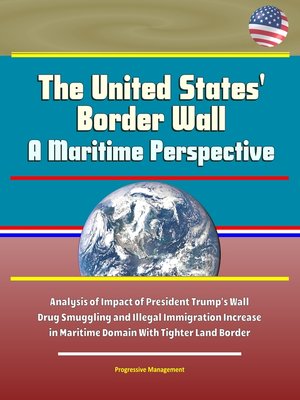The United States' Border Wall
ebook ∣ A Maritime Perspective--Analysis of Impact of President Trump's Wall, Drug Smuggling and Illegal Immigration Increase in Maritime Domain With Tighter Land Border

Sign up to save your library
With an OverDrive account, you can save your favorite libraries for at-a-glance information about availability. Find out more about OverDrive accounts.
Find this title in Libby, the library reading app by OverDrive.



Search for a digital library with this title
Title found at these libraries:
| Library Name | Distance |
|---|---|
| Loading... |
This report has been professionally converted for accurate flowing-text e-book format reproduction. The President of the United States has requested increased security at the southern border, mainly by investing in and building a border wall. Some argue that this will cost too much money, and some argue that it simply will not be effective. Conversely, others would argue that it is a necessary tool within the United States' border security policy. This thesis examines a potential border wall's effectiveness by analyzing illegal immigration apprehensions and drug seizures. Furthermore, this thesis uses the southern border's existing border fencing as an example of how border infrastructure affects the flow of illegal immigrants and drugs. In addition to the land border, this thesis hypothesized that, based on historic border security data, an increase in land border security will result in an increase in illegal immigration and drug smuggling through maritime routes. So, illegal immigration and drug smuggling data from before and after large amounts of border fence mileage were constructed was compared from land and maritime perspectives. This research found that a border wall can be effective at redirecting the flow of people and drugs, but ineffective at the greater goal of stopping it. Also, this thesis discovered changes in maritime border security data that suggest that as security is increased on the land border with border barriers, the maritime domain will experience significantly more drug smuggling and illegal immigration.
This compilation includes a reproduction of the 2019 Worldwide Threat Assessment of the U.S. Intelligence Community.
This literature review and background suggest that the border wall will not be effective at stopping immigrants or drugs from entering the country, mostly because of increasingly sophisticated smuggling techniques used by transnational criminal organizations. Although the wall may have some success in certain individual border sectors, it will not stop illegal immigration and drug smuggling completely. This thesis hypothesizes that the border will instead be effective at diverting flows of people and drugs into other areas and will result in a rise of illegal immigration and drug smuggling through the water to the East and West of the border wall. The research for this thesis is directed toward border security on land and at sea. Illegal immigration and illegal drug smuggling data was analyzed and was used as indicators of effectiveness for the border wall and border security as a whole. Also, the thesis examined the relationship between land and sea border security by analyzing illegal immigration and drug smuggling data before and after the United States constructed border barriers as a part of its border security strategy. Specifically, data was compared from the 1980s to 2006, the year the United States created the Secure Fence Act and significantly shifted its border security policy and constructed just under 750 miles of fencing in four years, then from 2009 to the present. The immigration and drug smuggling data from the southern land border was primarily found in CBP records. The immigration and drug smuggling data from the maritime borders was derived from USCG and CBP records. Background and amplifying information were collected from government reports, news articles, and journal articles. If the hypothesis is correct, this research should find that although illegal immigration and drug smuggling have decreased along the land border, they have increased on our maritime borders.







